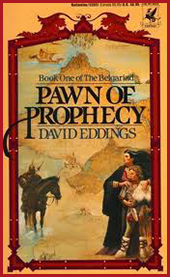To truly enjoy the work of the late David Eddings[i], the reader must be aware what they are getting themselves into. It helps if you aren’t all that familiar with the fantasy genre, and it helps if you’re young and don’t know any better. Before you set out, it is also ideal to choose which Eddings series you are going to start with. It is inadvisable to attempt to read both The Tamuli and The Belgariad and their respective sequel series[ii], because the very point of the books is to be formulaic and it is quite easy to become tired of that formula, unless you pace yourself carefully. Or unless you just don’t care. Just not caring is another helpful quality if you wish to fully enjoy Eddings’ fiction.
As a young reader, relatively new to the world of grown-up fantasy novels[iii], I chose The Belgariad over The Tamuli simply because a friend of mine happened to own them and I started reading them while I was over there. I did later attempt The Tamuli, but since I was a teenage girl, I found the hero of The Belgariad, naïve farmboy Garion, significantly more identifiable than the battle-grizzled, middle-aged Sparhawk[iv]. I believe I made the right decision. My memories of The Belgariad are rosy and when I recently reread the series, I was pleased to learn that, while the flaws of the series were somewhat more glaring, I still found the same level of joy from the world and its characters.
The Belgariad is the story of young Stock 80s Fantasy Hero Garion. Garion spends his formative years on an idyllic farm in rural Mary Sue Country, under the watchful eye of his beloved Female Archetype aunt, Pol. He is also visited with increasing frequency by an un-noteworthy vagabond called Mr Wolf. All, of course, is not well in Mary Sue Country, and it becomes clear that Garion is being watched by other, darker[v] eyes, and to make matters worse, the benevolent farm-owner has hired a man with poor personal hygiene and a lazy eye. Garion, after spending much of his time confused while the adults around him discuss the various portents and veiled plot-hooks, is swept up on a cross-country quest he does not fully understand. He is not happy. Anyone who bothered to read the prologues[vi] will of course know Garion’s secret identity. Nonetheless, the series attempts to keep this information secret until almost three-quarters of the way through.
The plot is not the most important thing about The Belgariad. It is a generic fantasy plot involving a quest for an Artefact of Doom and concerns itself largely with the doings of the nobility in a world that is jaw-droppingly simplistic. The characters, too, especially the women, are archetypes, and are highlighted as such by the various Prophecies that waft through the text. Given the sheer number of characters, however, it is something of an achievement to have found a separate archetype for all of them. If you expect a complex, gripping plot, a deep understanding of society or geopolitics or the way human beings function in their world, and a mythology you could drown in, The Belgariad is not where you should look. The series is not a work of High Art. It challenges none of the fantasy conventions of its time. In fact, it takes almost all of them and runs. It is racist, and though the author/s quite possibly didn’t think so, it is sexist as well.
However, unlike some fantasy authors I could name, Eddings is gloriously self-aware and clearly enjoyed himself in producing these five books. The fun of The Belgariad is most evident in its dialogue. The books are stuffed with witty banter and sarcasm, from all parties save our Generic Hero, who is neither clever nor witty and serves chiefly as a means to introducing the others. The characters, despite being archetypes, are for the most part likeable and there are so very many of them, it would be difficult not to find at least one favourite.
Eddings could never have been accused of taking himself too seriously in producing these books. If you appreciate the type of dry humour most evidenced in them, and are willing to leave your brain at the door, you will have fun with The Belgariad. Thus I recommend them to you reservedly.
[i] Later works co-credit Eddings’ wife Leigh as an author. It is, in my opinion, likely she co-authored his early novels as well.
[ii] If you happened to enjoy The Belgariad and wish to revisit that world and its characters and the general fun, don’t read The Mallorean. Just don’t.
[iii] To a given value of ‘grown-up’, I grant you.
[iv] I also took a strong dislike to the name ‘Sparhawk’, which didn’t help.
[v] This book is pretty racist.
[vi] I should probably declare myself an anti-prologuer here.



This is great! I’m sorry I didn’t get around to reading it until now. The style is glorious! I can’t wait to see your next one.